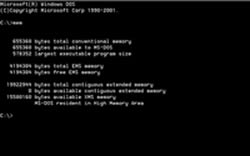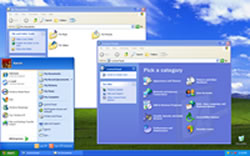Difference between DOS and Windows
Key Difference: DOS or Disk Operating Systems are operating systems that were most commonly found the IBM PCs and were popular between 1981 and 1995. Windows is a range of graphical interface operating systems that are developed and sold by Microsoft.
Before the Windows vs. Apple war and when times were simpler, there was a computing system known as DOS (Disk Operating System) which dominated the IBM PC. Back then when you bought a computer, it was most commonly an IBM that had a DOS operating system. DOS and Windows differ from each other in many aspects.
 DOS or Disk Operating Systems are operating systems that were most commonly found the IBM PCs and were popular between 1981 and 1995. Many DOS versions have been released by different companies, the most popular being the MS-DOS, also by Microsoft. Related systems include MS-DOS, PC-DOS, DR-DOS, FreeDOS, PTS-DOS, ROM-DOS, Novell DOS, OpenDOS and 86-DOS. The 86-DOS or QDOS (Quick and Dirty Operating System) was bought by Microsoft for the IBM PC.
DOS or Disk Operating Systems are operating systems that were most commonly found the IBM PCs and were popular between 1981 and 1995. Many DOS versions have been released by different companies, the most popular being the MS-DOS, also by Microsoft. Related systems include MS-DOS, PC-DOS, DR-DOS, FreeDOS, PTS-DOS, ROM-DOS, Novell DOS, OpenDOS and 86-DOS. The 86-DOS or QDOS (Quick and Dirty Operating System) was bought by Microsoft for the IBM PC.
Windows is a range of graphical interface operating systems that are developed and sold by Microsoft. Early versions of Microsoft Windows ran on top of a separate version of DOS and it ceased to be used when Windows 95 was launched as a stand-along operating system that did not require a separate DOS license. With Windows 95 and 98, but not ME, the MS-DOS component could be run without starting Windows. When DOS was no longer required to run the system, it was completely stopped being used in PCs. The DOS is now obsolete and is very rarely used in the real world. DOS and Windows differ from each other greatly even though Windows is believed to be derived from DOS.
 DOS and Windows differ in GUI (graphical user interface), where DOS uses a full text command input, Windows uses images, icons and text in their interface. The full text command input in DOS required users to input commands and work on the computer using text codes; making it harder to understand for first-time users or less tech savvy people. Windows simplified the graphical user interface, by using the help of icons, images and text; eliminated the need for remembering the codes and the actions that go with the codes.
DOS and Windows differ in GUI (graphical user interface), where DOS uses a full text command input, Windows uses images, icons and text in their interface. The full text command input in DOS required users to input commands and work on the computer using text codes; making it harder to understand for first-time users or less tech savvy people. Windows simplified the graphical user interface, by using the help of icons, images and text; eliminated the need for remembering the codes and the actions that go with the codes.
DOS also offered less storage space compared to Windows. The highest storage space that DOS offered came around 2 gigabyte, while the latest Windows offers storage space in terabytes. Windows can also accommodate much larger hard drives, while DOS cannot due to its dependence on FAT16 file system.
DOS and Windows also differ in terms of registry systems and swap files. While DOS uses a directory system, where all the files are contained within a particular directory or a subdirectory, Windows uses a much complicated registry system making it difficult to manually delete files from the system and excessive files can cause the system to slow down or crash.
Due to the decline of usage for DOS, most versions of DOS are now available for free in the market. It is also simple to use and does not require gigabytes of memory in order to work compared to Windows. DOS has become ideal for prototyping, testing, and making automated systems that only require checking if and when something goes wrong. Due to its simplicity in usage and lack of fancy GUIs, the system is also much cheaper to operate.
|
|
DOS |
Windows |
|
Definition |
DOS (Disk Operating System) are simple text command operating systems that were popular from 1981 to 1995. |
Windows is a range of graphical interface operating systems that are developed and sold by Microsoft. |
|
GUI |
DOS used a text based interface that required text and codes to operate |
Windows uses graphics, images and text. |
|
Input System |
Text is used as the basic input system commands. |
Uses a mouse for all operating system input. |
|
Multitasking |
DOS is unable to run multiple processes at the same time. |
Windows is a multitasking operating system; allowing more than one process to work simultaneously. |
|
Storage Size |
The highest amount of storage size available is 2GB. |
Window systems offer storage space up to 2 terabyte. |
|
Demands on System Resources |
Booting up system is DOS is less demanding on the CPU. |
Booting up Windows is more demanding on the CPU. |
|
Registry and Swap Files |
DOS uses a directory system, where all the files are contained within a particular directory or a subdirectory. |
Windows uses a different registry compared to DOS, making it difficult to manually delete programs. An excessive number of temporary files and file fragments can cause the system to slow down or crash. |
|
Current Uses |
More ideally used for prototyping, testing, and making automated systems. |
Used worldwide as the most popular operating system. |
|
Price |
DOS is free |
Windows is costly |
Image Courtesy: watchplayread.com, wikimedia.org









Comments
Rahila Rafiq
Sun, 11/01/2015 - 17:59
Ganesh Dangode
Sat, 10/24/2015 - 00:32
Alok Yadav
Tue, 10/13/2015 - 17:27
Thank you very much
aman
Fri, 07/03/2015 - 04:38
Thanks for this info.......it really help me tho on my assignment
@Lanrexwel
Fri, 05/15/2015 - 21:58
i got exactly what i was looking for thanks and GOD YOU ALL
MR.TIMS
Tue, 04/28/2015 - 05:07
Many thanks to this page for these infos....I must confess that i am now gurufied than before. A problem which kept me on darkness for years, but i am now ok.
dalhatson
Thu, 03/12/2015 - 15:06
This information really help me. I am now a Guru on computer with your inteligent help
dalhatson
Thu, 03/12/2015 - 15:02
thank you for share!
louis vuitton s...
Thu, 01/22/2015 - 20:27
Clarified my doubt.thanks a ton
divya
Sun, 12/07/2014 - 22:39
Pages
Add new comment